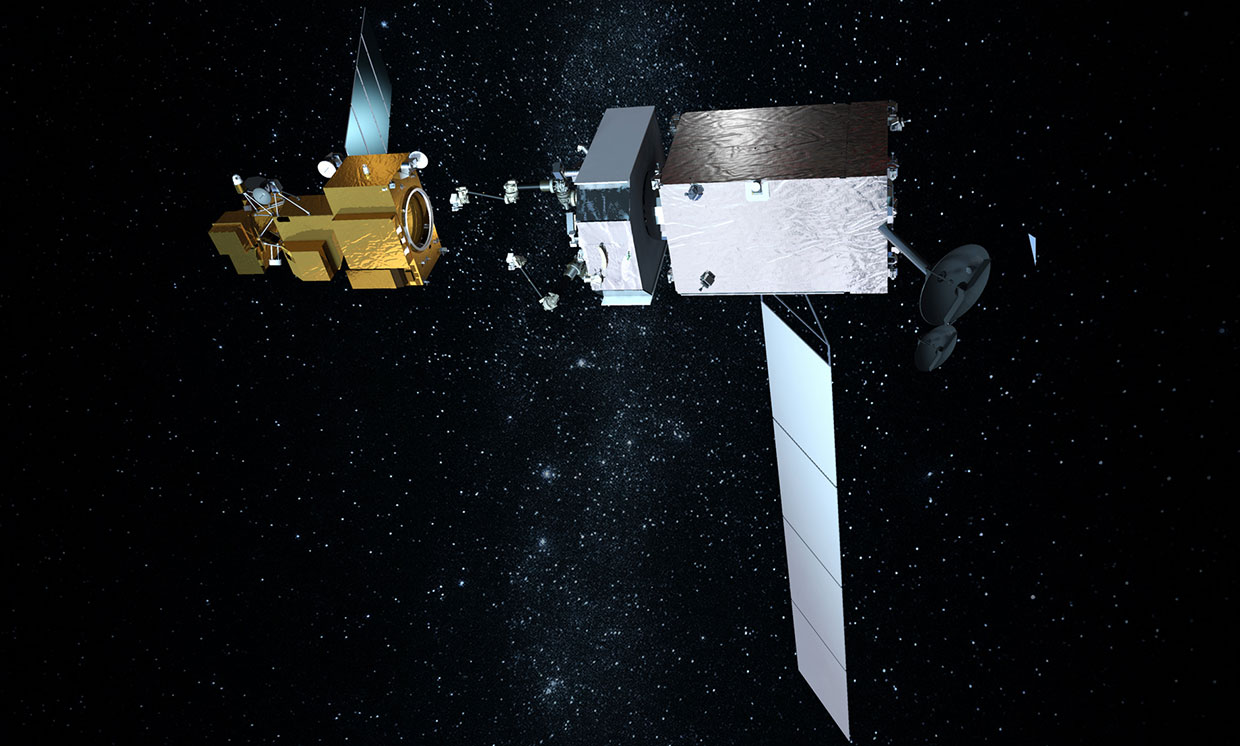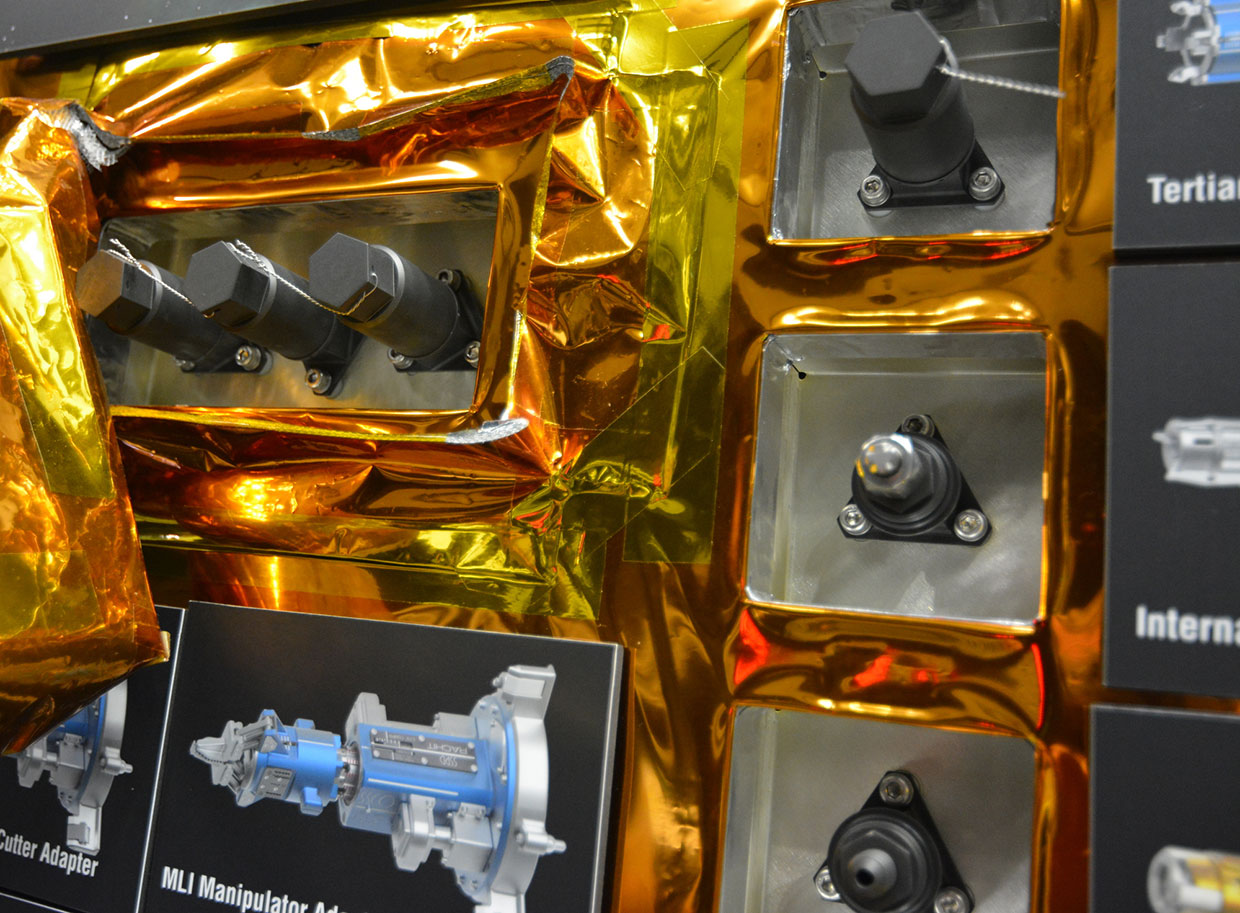In 2022, NASA's robotic spacecraft will service Landsat 7

In the foreseeable future, access to space will remain extremely costly. Even when using tricks such as reusable rockets or launching from balloons and giant planes, the cost of putting a kilogram of payload into a low Earth orbit is still several thousand dollars. And as soon as you put something into orbit, then it (with a few exceptions) turns out to be left to its own devices, and you can only hope that it will complete its task before it runs out of fuel. After that, most satellites are useless.
In general, such a system seems extremely inefficient. NASA would like to change this, and considers it a great idea to place repair workshops and gas stations in space. Several satellite service programs are in various stages of development, and this year the IEEE Spectrum magazine team visited the NASA's Goddard Space Flight Robotics Technology Center to learn more.
RSGS
This year, the Geosynchronous Satellite Service Robotics Service (RSGS) project from the Department of Defense Advanced Research Projects Office (DARPA) was suspended when the main contractor, Maxar Technologies, refused to create equipment for him. DARPA was looking for new partners for the project and expects that it will be able to announce new agreements by the end of this year, and the RSGS project itself will be launched in 2023. RSGS is a semi-automatic spacecraft with two robotic manipulators, which will have to serve the geosynchronous satellites, and repair their problems in order to extend the service life. The video shows a concept of how valuable this technology can be - a stuck solar panel can erase the existence of a completely new satellite, while solving this problem (and saving hundreds of millions of dollars) can be as simple as a little push in the right direction.
Rrm
RSGS mainly focuses on fixing satellites, but there is another great opportunity to work in orbit - it's refueling; because the lifetime of most satellites is determined by how much fuel they have in stock. Several NASA robotic refueling projects sent test equipment to the ISS to determine the best way to refuel satellites whose project did not include such actions. Such satellites (yes, in general, all satellites) on Earth are tightly wrapped up, gas valves are tightly wrapped, fixed with wires and covered with thermal insulation. To refuel satellites, you will have to completely remove all this, and in a completely abnormal way.
NASA's robotic refueling missions (RRMs) started in 2011 and sent test equipment the size of a small refrigerator to the ISS. Using copies of satellite valves, real fuel and a set of tools that a robotic arm is capable of controlling at the station, NASA tested the RRM missions and established a set of procedures for the practical refueling of satellites in orbit. The most recent RRM3 mission was launched in December 2018 to verify the transfer of cryogenic fuel; it must be stored refrigerated, but potentially it is much more powerful than hydrazine monofuel , which is used in the engines of most satellites. In April of this year, RRM3 lost its ability to cool fuel, and it had to be thrown into space, but NASA was still able to check all the tools and procedures for transferring fuel, even without the fuel in the tanks.
Restore-l
The Restore-L project combines service and refueling functions - and at the moment this is the most interesting satellite service project. Restore-L will become a robotic spacecraft that implements everything that NASA learned about maintenance and refueling. He will visit Landsat 7, a US government-owned remote sensing satellite located in Earth’s low orbit in 1999, and capable of operating on its own fuel until 2021. The mission is ambitious, but it has enormous benefits: Landsat 7 costs more than half a billion dollars and will great if we can refuel and leave him and other satellites in service.

Artist's drawing: Restore-L (bottom) is about to capture and service Landsat 7
The most important Restore-L components are being developed at NASA's Goddard Space Flight Center (GSFC), while Maxar is working on the ship’s bus and robotic arm equipment. We met with Brent Robertson, the project manager for Restore-L, in a cave-like black-wall robotics center where they check hardware and Restore-L software. At the end of the project, it will be a pair of large robotic arms capable of capturing satellites, with a set of tools and a bunch of sensors that allow both to remotely control it from the Earth and function completely autonomously.
The Landsat 7 refueling mission will include a complex procedure typical of refueling any satellite. Restore-L will have to:
- Autonomously capture Landsat 7.
- By means of a remote control with a tool, cut off the insulating covers protecting the filling and discharge valves.
- Using another tool, cut the wires on the valves.
- Unscrew valve covers.
- Attach a port with quick disconnect to the filling valve.
- Transfer 115 kg of hydrazine to the satellite.
- Close everything with thermal insulation, and make sure that nothing has escaped into space.
“Landsat 7 was chosen because this satellite is representative enough,” says Robertson. Like most satellites. It has a Marman ring, a structural component that once connected it to the upper stage of the rocket, and now provides a standard and convenient grip point for the Restore-L robotic arm. Different satellites may have different filling valves, and Restore-L will have tools designed for Landsat 7, but in general the procedure should be more or less the same, and the tools can be replaced if necessary.
Importantly, Landsat 7 is representative in that it was not planned to refuel, Robertson says. “When they launched Landsat 7, they did not plan to refuel it. No one thought it would be possible. And we will be the first to show it. ”
The most difficult part of the mission will begin, most likely, after Restore-L catches up with Landsat 7 and begins a maneuver for capture. It cannot be controlled remotely, because even a delay of one or two seconds will be too long for such a delicate operation - in microgravity conditions, a miss can cause Restore-L and Landsat 7 to spin uncontrollably, or even damage Landsat 7. The capture must go autonomously, and on Restore -L cameras for the visible spectrum, infrared cameras and a lidar for space, developed at GSFC, will be installed. Well, if something goes wrong, the ship must be smart enough to turn back.

Partial Landsat 7 model installed on a microgravity-simulated robotic installation
GSFC comprehensively tests equipment on Earth, preparing for this autonomous capture in orbit. The operating robotic center houses a full-scale model of the lower part of Landsat 7, mounted on a six-legged robot, whose legs simulate six degrees of freedom in motion experienced by Landsat 7 in flight.

One of the manipulators Restore-L
The Restore-L grip, which has seven degrees of freedom, is long enough to grab Landsat 7 from a distance of a meter, and the wave gear motors in the grip joints guarantee accurate operation with minimal backlash. Grip torsion sensors allow it to autonomously evaluate the grip force of the target.
As soon as Restore-L grabs the target properly, it opens up many possibilities, Robertson says. “Restore-L has many abilities, we can do much more than just refuel Landsat 7. Cutting, unscrewing and refueling is difficult. However, we have an extensive range of satellite capture and movement capabilities. ”
One of the problems is that Restore-L may not always have the tools it needs to refuel with itself. Since satellites were designed without serviceability, there was no point in standardizing filling valves or making access to them easier. GSFC has developed robotic-friendly valves that will facilitate this work, and is happy to license this technology to everyone, but so far these valves are not on the satellites. “The situation is similar to the problem of chicken and eggs,” says Robertson. - No one was engaged in robotic maintenance, so until they show it, operators will be reluctant to invest in maintenance - until they see that it is possible. I think that when we really show everything on Landsat 7, you will see how the industry will appreciate the opportunity. ”

Just a few of the many thermally insulating coatings, valves and fittings that Restore-L has to deal with
After our tour of the Robotics Operations Center, we asked Robertson some questions about the future maintenance of satellites.
IEEE Spectrum: Now there is a tendency to reduce the size and cost, and to increase the number of satellites. What can large satellites be able to offer to make their service useful in the long run?
The computing power that can be sent into space in ever-decreasing satellites is constantly growing. However, some things still require large apertures, such as antennas or mirrors. Some studies are conducted by people. If we are going to the moon and to Mars, we will need robots collecting various things. And this is not just a more economical option, but also necessary.
Besides extending the life of old satellites by refueling them, can your technology create new opportunities for these satellites that they would otherwise not have?
Yes. Our main mission is to refuel Landsat 7, however we have many additional abilities. So far, the size of the satellites is limited by the useful volume of rockets bringing them into orbit, and this limits everything from the size of the mirror in the telescope to the size of the antenna for communication satellites. However, when we have a robot in space, this will allow us to move away from this paradigm - it will be possible to make several launches, and then show the manufacture and assembly of things in space. And this will lead to the creation of a new class of missions.
Is that how we should imagine Restore-L in the long run?
That's how I imagine him! We demonstrate a lot. We will be the first in many ways, but we will not be the last. No one knows what space will be like in 30 years, but I’m sure that there will be much more robots there than today. All of these satellites are extremely expensive - some of them are worth more than a billion dollars. And if something suddenly does not work out, then the mission is considered unsuccessful. But if there are robots in space, you will have the opportunity to unstick parts, take parts, move parts. Potentially, when the technology has developed sufficiently, it will be possible to add new capabilities to satellites, increase the functionality of satellites, launching into space not a whole new satellite, but only a detail from it.
In space now there are a large number of dead satellites, a lot of equipment. You can start thinking about saving this equipment with robots. It will be possible to take this upper stage, which contains electronics worth millions of dollars, and use it - it lacks only fuel. All this can be saved. Or you can take two different devices and combine them. I will not be surprised if in 20-30 years people will catch non-working satellites and re-profile them for other purposes.
* * *
Restore-L is planned to be launched no earlier than December 2022, unless, of course, the system passes all the checks and funding continues. If Landsat 7 service is successful, then 115 kg of fuel that Restore-L can pump into Landsat 7 will fill the tank of the latter and extend its operation for several years. And Restore-L will remain in orbit, where it can help NASA develop new technologies for maintenance or construction.